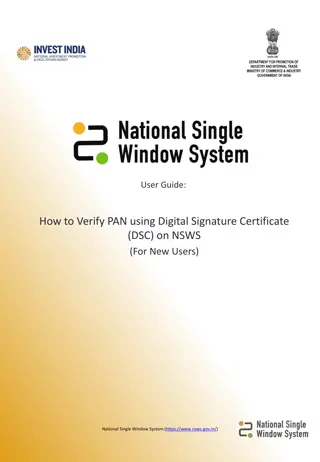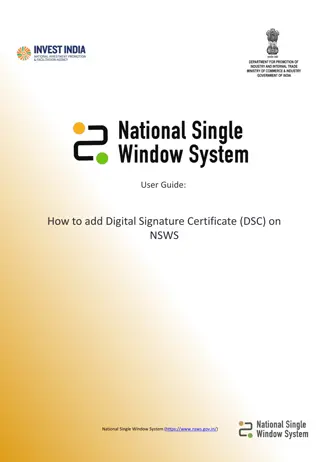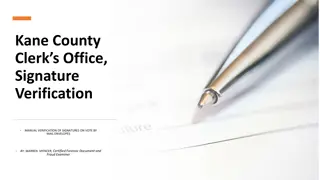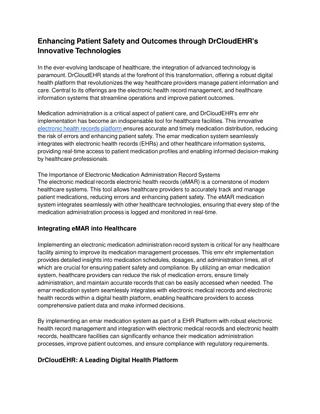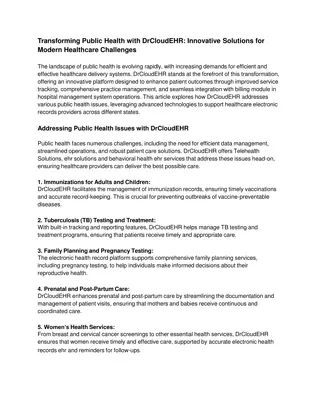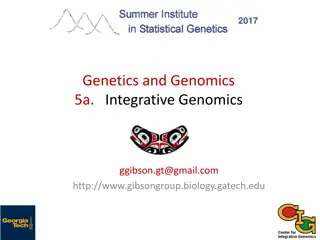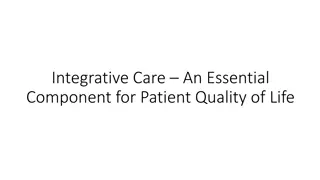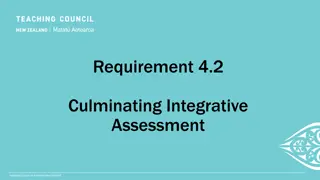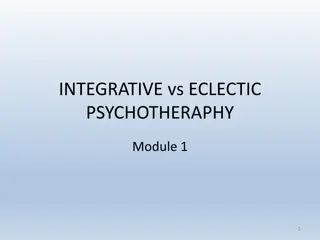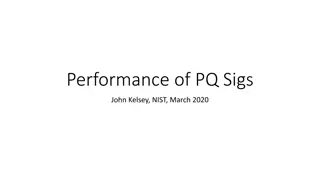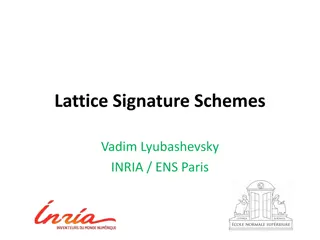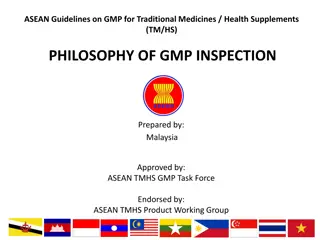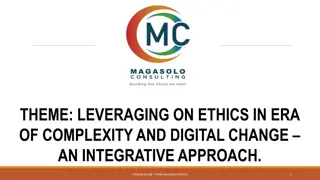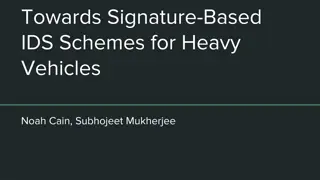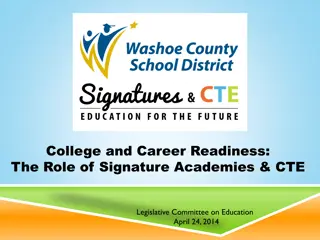Future of Integrative Learning & Signature Work Overview
Integrative learning aims to prepare students for success in a complex, global environment by providing common learning outcomes and assessments. With a focus on redefining student success and empowering people, this educational approach enhances student competencies through innovative experiences and interdisciplinary projects. The LEAP program emphasizes broad knowledge and real-world experience for graduates.
Download Presentation

Please find below an Image/Link to download the presentation.
The content on the website is provided AS IS for your information and personal use only. It may not be sold, licensed, or shared on other websites without obtaining consent from the author.If you encounter any issues during the download, it is possible that the publisher has removed the file from their server.
You are allowed to download the files provided on this website for personal or commercial use, subject to the condition that they are used lawfully. All files are the property of their respective owners.
The content on the website is provided AS IS for your information and personal use only. It may not be sold, licensed, or shared on other websites without obtaining consent from the author.
E N D
Presentation Transcript
Focus on the Future: Integrative Learning & Signature Work General Overview
Ultimate Objectives Systematically Improve and Reinforce Student Learning Prepare graduates for success in a complex, global environment Provide Common Learning Outcomes and Assessments Make the language of learning consistent and transparent across BGSU Make a BGSU education distinctive while providing coherent argument for higher education
Focus on the Future Redefining Student Success Provide undergraduate and graduate students (traditional and post-traditional) a demonstrably superior and innovative learning experience that intentionally prepares them to lead meaningful and productive lives. Objective 1
Redefining Student Success A. We will review all programs to ensure that we are intentionally (not passively) preparing students to achieve competencies appropriate for personal and career success. We will ensure that our learning outcomes are focused on both the mastery (knowing) and competencies (doing) of content knowledge. With a focus on doing, we will further leverage BGSU s strength in providing high-impact practices, such as study abroad, internships and co-ops, undergraduate research, service-learning and learning communities. Additionally, we will expand experiential education by requiring every student to complete an interdisciplinary signature project that addresses an important societal issue. This builds on the work of our Center for Civic and Community Engagement and the Vital Communities Initiative and aligns with BGSU s mission to create public good through our students, faculty, staff, and graduates. Objective 1 1.a
Focus on the Future Objective 3: Empowering Our People We will significantly improve the quality of teaching and learning by implementing student- centered initiatives that ensure our learning environment sets clear expectations, supports one another, intellectually engages and involves students, and provides feedback and assessment. Objective 3.2
What is LEAP? Liberal Education and America s Promise LEAP: AAC&U s national advocacy program promoting liberal education focused on broad knowledge, higher order capacities, and real-world experience for graduates to thrive in the economy and in a globally engaged democracy. (AAC&U, 2005)
Origins of LEAP Blends many recent approaches to learning: Authentic Learning Experiential Learning Problem-Based Learning Project-Based Learning Service Learning Learning Communities Collaborative Learning Deep Learning Habits of Mind
What is Integrative Learning? "Integrative learning is an understanding and a disposition that a student builds across the curriculum and co- curriculum, from making simple connections among ideas and experiences to synthesizing and transferring learning to new, complex situations within and beyond the campus." (Rhodes, AAC&U 2009).
What is Signature Work? A student-defined project in which students use their cumulative learning to pursue a significant project related to a relevant societal problem they define. In the work conducted throughout at least one semester, students take the lead and produce work that expresses insights and learning gained from the inquiry and demonstrates the skills and knowledge they acquire. Programmatic requirements should ensure that students can demonstrate the Essential Learning Outcomes in a culminating Signature Work course or experience. (Gaston, AAC&U, 2015)
Signature Work 2 An authentic task through which a student develops and performs learning Allows for Authentic Assessment : situated, relevant, iterative To improve a student s learning To improve our teaching and curricula
Learning Outcomes 1-3 ELO-1 Connections to Experience Students will connect relevant experience and academic knowledge in a way that deepens understanding and broadens points of view. ELO-2 Connections to Discipline and Across Disciplines Students will make connections across disciplines and perspectives by integrating examples, concepts, and theories from multiple fields of study or perspectives. ELO-3 Transfer Students will reframe and adapt learned skills, ideas, and methodologies to a new situation in a way that solves a complex problem or issue in an independent and original way.
Learning Outcomes 4-5 ELO4 Integrated Contextual Communication Students will choose forms of communication that enhance meaning and make clear the connections among language, meaning, thought, and expression across communities. ELO5 Reflection and Self-Assessment: Students will design a future self, building upon past experiences, both successes and failures, that have occurred across multiple and diverse contexts.
Initiative Objectives: SW Put a Signature Work experience into every major Convert Capstones or Other High-Impact Practice Create new Signature Work experiences 35% of majors approved for Fall 2021; 20% per academic year. HLC Quality Initiative
Initiative Objectives: IL Incorporate Integrative Learning Outcomes into all curricula. Same Learning Objectives Scaffolded First Courses in Majors Gateway Courses Core Courses Experiential, Service, Research Experiences Communication in Context: Supports ELO-4
Communication in Context Focus on Transfer: application of communication skills in varying contexts Communication (oral and written communication) at advanced levels in authentic tasks Communication within, between, and across disciplinary boundaries Faculty and Curricular Development
Learning Environment Mutually support and reinforce: Life Design Bowling Green Perspectives Undergraduate Research Experiential Learning, especially Internships Co-Ops Community Engagement, Service Learning
Professional Development Leverage Extant High Impact Practices Professional Development on Learning Outcomes, Learning Design, and Pedagogical Practices that support Integrative Learning
Pedagogical Practices Intentional meta-discourse that blends Integrative Learning particularly in BGP and Core Curricula with Life Design Signature Pedagogies: Approaches to Teaching Disciplinary Habits of Mind (Gurung, et al., 2009)
Assessment Authentic Assessment FROM testing knowledge gaps, recollection, products TO demonstration of skills, competencies and knowledge applied in increasingly authentic tasks VALUE Rubrics (Valid Assessment of Learning in Undergraduate Education)
Curricular Engagement Adoption of Backward Design: What do we want our students to look like when they graduate? Curricular Design from this student-centric perspective Not driven by Subject Matter, Content, Coverage
Learning Design Institute practices to engage faculty and other curricular brokers in backward design of all curricula Institute expectations for Integrative Learning into all curricula Institute expectations for authentic assessment in curricular development and modification Site of these expectations: centered in academic units, but all curricular brokers and especially college curricular bodies and Undergraduate Council
Process 1 Associate Dean identify and contact programs Faculty in unit determine and execute course of action: Revise Capstone Course Create new Signature Work Course Revise current experiential activity requirement Create new Signature Work Requirement a) b) c) d)
Process 2 Faculty consults these materials (from A-Dean): Signature Work Guidelines Integrated Learning Outcomes Template(s) for SW Approval Samples Bloom s Taxonomy BGSU/Revised a) b) c) d) e) Completed Template is then reviewed: Office of Academic Assessment Associate Dean Approved by Unit Curricular Body & Chair/Director Send to College Curricular Body 1. 2. 3. 4.



